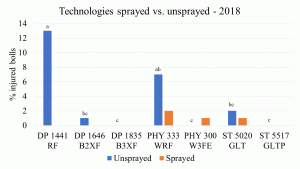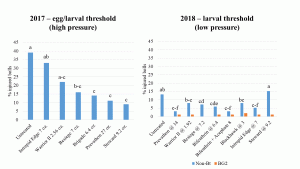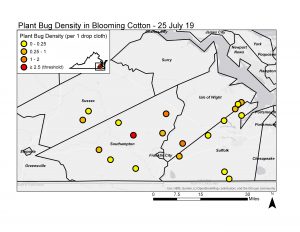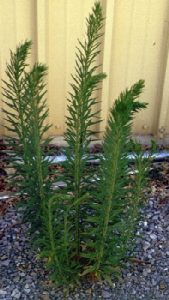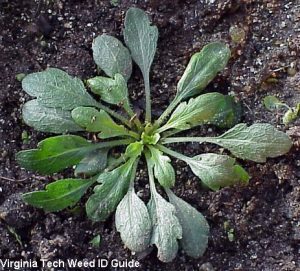Corn earworm (= bollworm) moth catches were exceptionally high this week, continuing to climb in Dinwiddie, Prince George, and Suffolk, VA black light traps. The average number captured per night was 38 in Greensville, 79 in North Dinwiddie, 72 in Prince George/Disputanta, and 124 in Suffolk. Thanks to Sara Rutherford, Scott Reiter, and the Tidewater AREC entomology crew for their reports. Here is the Table.
Category Archives: Sorghum
Corn earworm/bollworm update for August 1, 2024
Corn earworm (= bollworm) moth catches increased greatly this week in southeastern Virginia black light traps. The average number captured per night was 50 in Greensville, 42 in North Dinwiddie, 39 in Prince George/Disputanta, and 67 in Suffolk. Thanks to Sara Rutherford, Scott Reiter, and the Tidewater AREC entomology crew for their reports. Here is the Table.
We have evaluated over 250 moths in our 2024 vial tests, with 57% surviving the 24-hour exposure to the pyrethroid insecticide, cypermethrin, at 5 micrograms per vial.
Corn earworm/bollworm moth update–July 25, 2024
Corn earworm (= bollworm) moth catches really started to increase this week in southeastern Virginia black light traps. The average number captured per night this week was 4 in Greensville, 11 in North Dinwiddie/Petersburg, 18 in Prince George/Disputanta, and 30 in Suffolk. Thanks to Sara Rutherford, Scott Reiter, and the Tidewater AREC entomology crew for their reports. Here is the Table
We have evaluated over 150 moths in our 2024 vial tests, with 61% surviving a 24-hour exposure to the pyrethroid insecticide, cypermethrin, at 5 micrograms per vial. Even though cypermethrin is no longer widely used, survival rates this high suggest we need to watch for some pyrethroid control failures, and to consider alternative chemistries when an insecticide is needed.
Integrated Weed Management Workshop
Plant bug / bollworm update for VA cotton
The much needed rain earlier this week also heralded the start of the moth flight in southeastern VA. Both eggs and adult moths are being picked up by scouting teams. So far, only a handful of fields are over recommended thresholds. I recommend scouting 2-gene cotton (Bollgard II, Widestrike, Twinlink) for eggs and applying Prevathon or Besiege when you find 25 or more per 100 terminals and/or leaves. If you planted 3-gene cotton, you are likely protected. We have measured very little benefit to spraying Widestrike 3, Bollgard III, and Twinlink Plus varieties for bollworm. In these varieties, finding 3 or more live second-stage larvae in one trip (or two worms in two consecutive trips, or one worm in three consecutive trips) triggers an application.
Other insecticides can control bollworm in cotton, but timing is critical. If you are using a pyrethroid, for example, target small worms. No product will clean up a problem field once worms are inside bolls.
Our team, lead by PhD student Seth Dorman, ANR Agent Josh Holland, and Dr. Sean Malone are scouting fields this week for lygus. Few problems fields were detected in southern counties today. However, fields were observed over recommended thresholds. At this point, many people have sprayed. Some may need to spray again and some may not. The only way to know is to scout.
Northern counties will be scouted this Friday and I will update the blog with our findings.
As always, you can reach out to me with your questions and concerns.
Herbicide Resistant Weeds Workshops Slated for Maryland, Virginia, and Delaware
A series of half-day workshops will be held in Maryland, Delaware and Virginia this winter for farmers interested in learning about the problems of herbicide resistant weeds and how to manage them. Hosted by University of Maryland Extension in collaboration with Virginia Tech and University of Delaware, these workshops are designed to equip farmers with the knowledge to improve weed control on their farms.
Farmers in the mid-Atlantic area are starting to see the impact of herbicide resistant weeds on their crop yields. With many problematic weeds now found throughout the region it is essential that farmers learn the key management strategies to control these weeds.
Sessions will cover integrated weed management tactics; palmer amaranth, common ragweed and marestail control strategies; and developing a weed management plan. There is no charge to attend and lunch will be provided. Pesticide (commercial and private) and CCA continuing education credits will be offered.
Workshop locations and times are listed below. Please RSVP to the respective meeting location to provide an accurate meal count.
February 25th (12 pm to 5 pm) Old Beale Sanctuary, 369 Queen Street,Tappahannock, VA 22560
To register call the Essex County Extension Office: at (804) 443-3551
February 26th (8 am to 1 pm) St. Mary’s County UME Office, 26737 Radio Station Way, Leonardtown, MD 20650. To register call the St. Mary’s County UME Office at 301-475- 4484
March 4th (8 am to 1 pm) Harrington Volunteer Fire Company, 20 Clark St, Harrington, DE 19952. To register call the UD Carvel REC, at 302-856-2585 (ext 540)
March 5th (8 am to 1 pm) Somerset Extension Office, 30730 Park Drive, Princess Anne, MD 21853. To register call the Somerset County Extension Office at 410- 651-1350
March 6th (8 am to 1 pm) Frederick County UME Office, 330 Montevue Lane, Frederick, MD 20712. To register, call the Frederick County UME Office at 301-600- 3576
March 7th (8 am to 1 pm) Chestertown Volunteer Fire Company, 211 Maple Ave, Chestertown, MD 21620. To register call the Kent County UME Office at 410-778- 1661
For more information contact Ben Beale at 301-475-4481, Michael Flessner at 540-315-2954, Matt Morris at 301-600-3578 or Mark VanGessel at 302-856-7303.
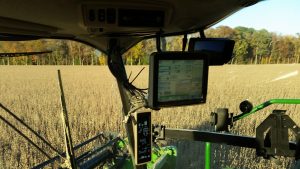
Calibrate your yield monitor – a checklist
While this post is likely too late for corn, it does apply to other crops. If you have yet harvested all of your corn, it’s never too late to calibrate your yield monitor.
First, I am no expert in calibrating yield monitors. My experience with the process only involves showing up to the farm with an accurate weigh wagon (or we use their grain cart), riding with the combine operator as he harvests a known area of the field, weighing the load and obtaining a moisture from the load (with a calibrated moisture tester), then watch him do the calibration.
Still, I understand the need for calibration although it takes time and may mean looking in the manual to learn or refresh one’s memory on the process.
John Barker, Knox County Extension Educator (Ohio State Extension) wrote an excellent article, “It’s almost that time of year … Don’t forget to calibrate your yield monitor!”, which is a step-by-step checklist of how to do this. I highly encourage all to read it.
We do have several weigh wagons located around the state that Virginia Cooperative Extension uses for our on-farm research. If you want me or one of your County Agents to help with this process, let us know.
2018 survey of field corn for corn earworm larvae
Statewide, approximately 18% of ears were infested with corn earworm larvae. Corn is considered a nursery crop for corn earworm, allowing the pest to complete a lifecycle and then move on to other crops such as soybean, cotton, and peanut in August. There is a linear correlation between the infestation level in corn and the amount of soybean acreage that gets treated with insecticide for this pest. Please see the attached pdf for more details: CEW_survey_results_2018
Section 18 for sulfoxaflor (Transform WG) on sorghum for sugarcane aphid
The EPA has granted a Section 18 for the use of Transform WG (50% a.i. sulfoxaflor) on sorghum for managing sugarcane aphid in certain counties in Virginia. The expiration date is November 30, 2018. All applicable directions for use, restrictions, and precautions on the label, and Worker Protection Standards, must be followed except as modified in the Section 18 document. In part, the Section 18 lists a foliar application rate of 0.75-1.5 oz of product per acre, with a maximum of 2 applications per year, resulting in a seasonal maximum application rate of 3.0 oz of product per acre per year. Please be sure to read and follow the entire label and Section 18. Thanks to the Virginia Department of Agriculture and Consumer Services, Office of Pesticide Services, for their assistance.
Time to start planning for horseweed/marestail
Charlie Cahoon and Michael Flessner, Extension Weed Specialists at Virginia Tech
Horseweed or Marestail
Horseweed is a winter or summer annual and a member of the asteraceae family. In the winter annual cycle, horseweed germinates in the fall and overwinters as a basal rosette. The following spring, the rosette bolts, reaching 1.5 to 6 feet in height. While most populations of horseweed in the region emerge in the fall, significant spring emergence can occur under certain conditions. Spring germinating horseweed does not form a rosette. Leaves are alternate, simple, linear to oblanceolate in shape, and lack petioles. Leaf margins are either entire or toothed. Flowers consist of numerous small heads arranged in a panicle with many white ray flowers and 20 to 40 yellow disk flowers. Seed are small and have a pappus of tan to white bristles (resemble dandelion seed). Seed are easily dispersed by the wind, allowing it to quickly spread to nearby fields and within fields.
Herbicide resistance: Regionally, glyphosate- and ALS-resistant horseweed are widespread. If you are unsure of the resistance status in your fields, assume resistance to glyphosate and ALS herbicides. Resistance to Gramoxone (PS I-inhibitor) has been reported in Delaware.
Management: Horseweed is more prevalent in no-till fields compared to fields prepared conventionally. Tillage can be useful in the long-term management of horseweed. Chemical control of horseweed is more consistent when the weed is in the seedling or rosette stage compared to bolting plants. Traditionally, glyphosate and ALS-inhibiting herbicides effectively controlled horseweed, however, biotypes resistant to these herbicides are wide-spread. Chemical control of glyphosate- and ALS-resistant horseweed requires a postemergence herbicide to control emerged horseweed and depending on application timing a residual herbicide for horseweed yet to emerge. Due to the prolonged germination period, horseweed seedlings can emerge 5 to 6 weeks after residual herbicide application, thus fall applications of residual herbicides often have limited effectiveness for spring emergence.
Herbicides used for emerged plants include 2,4-D (1 pt in the fall or 1 qt in the spring), dicamba, Liberty, Sharpen, or Gramoxone plus a triazine herbicide (atrazine or metribuzin). Preliminary research from Virginia and North Carolina suggest Elevore (a new auxin herbicide from Dow) also controls horseweed well. Fourteen days are required between Elevore application and corn or soybean planting and 30 days prior to cotton planting. Herbicides providing residual control include Valor SX, triazine herbicides (atrazine, simazine, and metribuzin), and ALS-inhibiting herbicides (if horseweed is not ALS-resistant).
Horseweed seedlings do not tolerate shade. Thus a well-established cover crop, or dense crop canopy can be very effective to manage horseweed infested fields.
Soybeans: The key to managing horseweed in in soybeans is to control it prior to planting. Horseweed needs to be controlled prior to bolting (grow upright); this may require an application weeks prior to planting. Glyphosate plus 2,4-D (1 qt/A), glyphosate plus dicamba or glyphosate plus Sharpen will effectively control glyphosate- and ALS-resistant horseweed when they are small. Pay attention to rotational restrictions of preplant burndown herbicides when planning burndown applications and planting. If horseweed are susceptible to the ALS-inhibiting herbicides, Classic-containing herbicides (i.e. Canopy, Valor XLT, Envive, Surveil) are effective. If applications are made early pre-plant, herbicides containing Valor SX or metribuzin or the Authority products can be included to provide residual control, or a second application of a non-selective herbicide may be needed at planting. Liberty or Gramoxone also control small horseweed and can be used as a part of the burndown application. If horseweed is present at planting, Gramoxone plus a residual product (Valor SX, Authority products, metribuzin, or Sharpen) is suggested in regions with later emerging horseweed. Foliar applied PPO-inhibiting herbicides (Blazer, Reflex or Flextar, Resource, and Cobra) DO NOT control emerged horseweed. For Liberty Link varieties, Liberty applied postemergence controls small horseweed. Classic and FirstRate are postemergence options where horseweed are susceptible to the ALS-inhibiting herbicides and are small.
Cotton: Like soybean, horseweed needs to be controlled prior to cotton planting. Burndown combinations of glyphosate plus 2,4-D/dicamba plus Valor SX is normally in order. Again, pay attention to plant-back restrictions when timing burndown applications. Glyphosate plus Sharpen is also effective, but requires a long waiting period between application and cotton planting.
Corn: In no-till corn, Gramoxone plus triazine, glyphosate plus atrazine plus 2,4-D or dicamba, and Liberty plus atrazine applied burndown of emerged seedlings and residual control of glyphosate- and ALS-resistant horseweed. Consult labels for waiting interval prior to planting corn. Atrazine alone will provide good residual control of horseweed. Dicamba and 2,4-D are the most effective postemergence herbicides. For small emerged horseweed, foliar applied HPPD-inhibitors or Liberty plus atrazine are effective.
Sorghum: Glyphosate plus Sharpen or Gramoxone plus a triazine applied burndown. Atrazine alone or in combination with Gramoxone applied preemergence for residual control and control of small emerged horseweed. Atrazine can be used postemergence for control of small horseweed. However, similar to corn, 2,4-D and dicamba are the most effective postemergence options.
Small grains: 2,4-D, dicamba, Quelex, or Huskie will provide effective postemergence control of horseweed in small grains. Harmony Extra is also very effective on small horseweed that is susceptible to ALS-inhibiting herbicides.
Fall fallow application: In fields with a history of horseweed, fall applied herbicides can be helpful in managing the weed. However, a fall herbicide application will not substitute for a spring burndown application. Target applications for emerged horseweed plants in the late fall after one to two killing frosts. 2,4-D or dicamba should serve as the base for these applications. Glyphosate is often suggested in combination with 2,4-D and dicamba to control other winter annual weeds.
To see similar information on other problematic weeds consult the Virginia Pest Management Guide: Field Crops at http://pubs.ext.vt.edu/456/456-016/456-016.html or the Mid-Atlantic Field Crop Weed Management Guide at https://extension.psu.edu/mid-atlantic-field-crop-weed-management-guide.
As always, don’t hesitate to contact Michael or myself with any questions or concerns.


